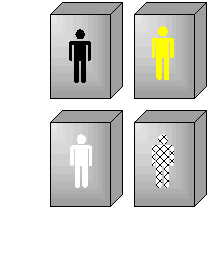Sort out the information on the Web
On the Web, we have the opportunity to create separate paths for each
group, displaying only the content appropriate for that group.
Each group can find the other material; but if we customize content by
niche, we show each group what interests them, first.
Figure out your niche audiences
Based on your research and talks with actual consumers, you can probably
figure out a half dozen niche audiences.
Niches form around
- Income
- Age
- Gender
- Geographic location
- Occupation
- Outlook
Don't rely on old demographics
Generally, people behave on the Web as they do in the rest of their life,
favoring certain brands, attitudes, ideas, and activities. So demographic
information developed over the years may help you flesh out what a
particular niche wants from your text.
But the Web also allows upper-income folks to visit stores they wouldn't
go into at the mall. And the Web shifts shopping times into the evening,
and dampens seasonal variations in purchasing. So you need to define your
own niches, based on your own research, supplementing it with the generic
stuff.
Nowadays, the customer relationship management folks think this way,
developing clusters of people around their shopping habits, interests, and
industries.
But so far most of this data is being used to determine which ads to
display to which visitors. Only the most advanced sites, today, customize
content for more than three or four niche audiences.
The smaller the niche you define, the better
The focus helps you figure out stuff like:
- What topics they care about
- What moves them
- What examples might make sense to them
- What ideas they resonate with.
Imagine writing in five different voices, for five distinct groups.
Adapt to each niche
As you become more attuned to the little groups within your audience, you
become a ventriloquist, or a character actor playing a series of roles.
This chameleon-like ability to take on the tone and attitude of a niche
audience is not as insincere as it sounds. People do this all the time, to
earn their way into a particular community, adopting that group's way of
talking.
Prove that you should be considered a member of the community.
Here's how:
- Show you recognize the divisions within the community
- Indicate that you agree on the boundaries of the community (who is in,
who is not)
- Accept the latest definition of what is hip, and not hip
- Stress the values and attitudes that are widely and deeply shared by the
community
- Follow the general agreement on what topics are important today
- Take sides in the arguments that go on continuously within the community
- Contribute new ideas, comments, and support to the ongoing conversation
(taking part, caring enough to hold up your end of the conversation)
- Position yourself in relation to the rest of the community (as a leader,
follower, troublemaker, what not)
- Use key slogans, totem ideas, and jargon in the right way (not like a
school principal trying to talk to kids in their own slang)
- Refer regularly to activities that people in this community take for
granted (and do not mention activities they disdain, can't afford, or
have never heard of)
Take on the group's identity
In writing for niche audiences, you may feel like a method actor pulling
out personal memories to build a new character.
To help clarify what you need to do to appeal to the niche audience,
you'll probably want to draw up some guidelines on what you feel
comfortable mentioning--lists of likely topics, positions, arguments.
And like an actor, you may also want to think of personal experiences that
resemble the activities, evoke the values, and support the ideas of the
group.
To succeed in writing for a niche, then, you must really join the niche,
wading right into the conversation.
For writers, of course, a community has more to do with their discourse
than their purchasing habits. Despite working for a particular site, and
taking its direction, you are adopting the group's style, adding to its
stock of ideas-and becoming a member.
Next:
Create personas!


